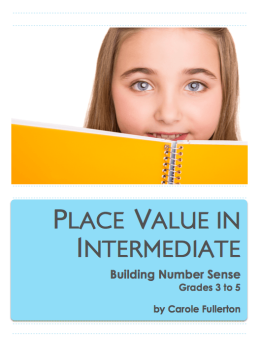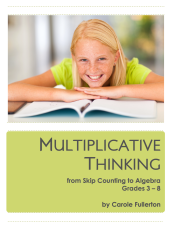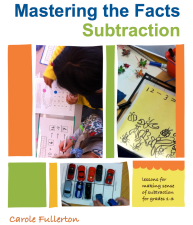Maintenant disponible en français!
Finally … French translations of my latest books are now available!
Je viens de traduire mes deux ressources de bonnes questions — “A Year of Good Questions for Grades 2-4” et “A Year of Good Questions for grades 5-8” — afin que mes collègues d’immersion aient des ressources françaises avec lesquelles travailler. Merci pour vôtre patience!
In these new French translations of the English originals, you’ll find more than 200 open-ended and engaging problems for french immersion students from primary through middle school. All are posed in French and explore important mathematical concepts across the grades.
 The first book: Bonnes Questions: Une année de bonnes tâches mathématiques pour les élèves de 2e à 4e is suitable for late primary students (grades 2-4) and features operational tasks, measurement tasks and pattern tasks of increasing complexity, posed in French.
The first book: Bonnes Questions: Une année de bonnes tâches mathématiques pour les élèves de 2e à 4e is suitable for late primary students (grades 2-4) and features operational tasks, measurement tasks and pattern tasks of increasing complexity, posed in French.
 The second volume: Bonnes Questions: Une année de bonnes tâches mathématiques pour les élèves de 5e à 8e is perfect for middle school immersion students (grades 5-8), with a focus on proportional reasoning, algebraic thinking as well as operations on integers, fractions and decimals to name a few.
The second volume: Bonnes Questions: Une année de bonnes tâches mathématiques pour les élèves de 5e à 8e is perfect for middle school immersion students (grades 5-8), with a focus on proportional reasoning, algebraic thinking as well as operations on integers, fractions and decimals to name a few.
Engaging problems and choice make these volumes the perfect conversation starter for our immersion classrooms, promoting oral language development and mathematical thinking …en même temps!
All are available from my online store.
Carole
New For Primary! Good Questions: A Year of Open-Ended Problems for Grades 2-4
For those of you who have been waiting ever so  patiently, I wanted to let you know that I have completed a primary companion to the Year of Good Questions for Grades 5-8 resource released this summer.
patiently, I wanted to let you know that I have completed a primary companion to the Year of Good Questions for Grades 5-8 resource released this summer.
A Year of Good Questions for Grades 2-4 is the late primary version of this stand up calendar of problems — one for every day of the school year!
Like its intermediate counterpart, this compact but potent book comes with an easel so you can set it up on your desk and flip from one rich problem to the next, posing open-ended questions of your primary students.

Good Questions: A Year of Open-Ended Math Problems for Grades 2-4 is a problem-a-day resource that includes rich tasks ideal for grades 2, 3 and 4. Organized by topic and structured in problem sets of 5, this simple to use teacher resource includes 200 mathematically important questions to engage your students in deep thinking. For only $25, it’s a reasonably priced way to stimulate and promote mathematical conversation!
Operations, measurement, proportional thinking and patterns are featured in this calendar of problems. Each one engages students in thinking flexibly, critically and creatively to solve tasks of varying complexity.
Visit my online store at mindfull.ecwid.com to order.
Let the fun begin!
Carole
New Resource! Place Value For Intermediate (Grades 3 to 5)

Phew! This one has been a long time in coming… :o)
My sincere appreciation to all of you who have waited for the publication of this book. As you know, I’ve had a pretty remarkable year. I hope you’ll forgive me, knowing that only good distractions delayed its completion!
But I am pleased as punch to announce the release of Place Value For Intermediate: Building Number Sense for Grades 3-5, available now from my online store for $50.
This resource for teachers of Grades 3 through 5 features lessons designed to support deep learning of number. A wide range of both open-ended and directed tasks focus on representing, describing, comparing and ordering numbers to 100 000, as well as explorations of decimal numbers to thousandths.
Measurement experiences make up a big part of this series of tasks. The metric system and all of its place value connections is featured in explorations of linear measurement (mm, cm, m, km), perimeter (cm, mm), area (square cm and square m), mass (g, kg) and capacity (mL, L).
Addition and subtraction of large numbers and decimals are also addressed in this volume. Lessons at the grades 4 and 5 level focus on multiplication of 1 by 2- and 3-digit factors as well as 2 by 2-digit factors using the distributive property (an area model).
Assessment tasks tap into students’ understandings of these numbers and their application in the real world. Being able to see and relate to big numbers and to very small ones, to understand their relative size and to capably use these numbers to estimate is the essence of number sense.
Set up in a developmental continuum intended to facilitate the teaching of combined grades, this 352 page volume is certain to contain material to meet the needs of all learners and to inspire fun and engagement with critically important place value concepts.
When you buy the book online, you also get access to almost 40 pages of digital files and resources, which will be emailed to you as a downloadable pdf!
Thanks for your continued support and inspiration…
Enjoy!
Carole
Financial Literacy in Primary – Thinking About Money in the Canadian Classroom
 Hello to my friends near and far… It has been a long time since I have posted anything to my blog, and for that I am truly sorry. To my faithful visitors, I offer you my thanks. I hope this latest instalment has been worth the wait!
Hello to my friends near and far… It has been a long time since I have posted anything to my blog, and for that I am truly sorry. To my faithful visitors, I offer you my thanks. I hope this latest instalment has been worth the wait!
My newest collaboration — as always, co-created with the inimitable Sandra Ball — is entitled Financial Literacy In Primary: Thinking About Money in the Canadian Classroom. This full-colour, 50 page resource is free to download – but you’ll need a password to access it. Please use the form below to contact me for the secret code. Read on to learn more. Enjoy! Carole
Financial Literacy — An Important Aspect of Numeracy
Beginning in the fall of 2016, concepts addressing financial literacy are being introduced to the Western Canadian mathematics curriculum. Although they have been included at the middle school level for a number of years, this is the first time that financial literacy as been highlighted in elementary — and most notably at the primary level. This raises some important questions. What is financial literacy at the primary level anyway? Certainly it is more than recognizing and naming Canadian coins! Structured instead around notions of earning, saving and spending and giving money, curricular outcomes dedicated to financial literacy are intended to look more deeply at what it means to be financially responsible.
Our youngest learners need support and explicit teaching to reach these goals. Engaging, authentic and meaningful tasks are critically important. Learning about money should be fun, of course, but should include notions of social responsibility — earning, saving and giving — as well as spending!
Playing with Money: Connecting to Number Sense
 In this new resource, Sandra and I have crafted a series of lessons to support teachers in introducing and developing ideas around financial literacy in Kindergarten through Grade 3. Currently there are few — if any — resources devoted to these ideas for primary students. We are hopeful this resource will fill that need!
In this new resource, Sandra and I have crafted a series of lessons to support teachers in introducing and developing ideas around financial literacy in Kindergarten through Grade 3. Currently there are few — if any — resources devoted to these ideas for primary students. We are hopeful this resource will fill that need!
Rich tasks, literature connections and games for practice in this resource are laid out along a continuum and are intended to be used across grades. In alignment with our new curriculum, these lessons are connected to both the core competencies (Thinking, Communicating and Personal and Social Responsibility) as well as to the curricular competenciesfor mathematics. By integrating financial literacy into our math program in primary, we create meaningful contexts for the math we are learning.
Think of the mathematical expertise our students will build as we represent and describe money amounts, compare and order values, skip count with coins and bills, use place value understandings and add and subtract dollar amounts!
 The Math Big Ideas for Financial Literacy
The Math Big Ideas for Financial Literacy
This teacher resource is structured around a set of Big Math Ideas for earning money, saving money and spending and giving money. These enduring understandings apply across the primary grades and beyond. By addressing these Big Math Ideas in developmentally appropriate and engaging ways we can ensure students have fun while they lay the foundations for ensuring financially responsible decision-making.
Sandra and I hope that this resource proves useful to you and fun for your students!
To download the materials, visit my online store (https://mindfull.ecwid.com) and click on the FREE DOWNLOADS icon.
Enjoy!
Carole
Math and Literature Resource for Grades K-3
 Hello all!
Hello all!
My colleague Sandra Ball and I have completed another resource for primary teachers!
Read A Story: Explore The Math promotes the teaching of important math concepts through the context of great children’s books… The lessons span K-3 and some are even appropriate for grades 3/4 classrooms. Lessons involving number sense and operations, data management, measurement and more are included in this 65 page resource. Scan through the list of titles and corresponding math concepts to sort out which children’s books would be a best fit for you and your students. The complete set of ISBN numbers for each of the stories is included so you can easily share ordering information with your teacher librarian…!
To download, please visit my online store (https://mindfull.ecwid.com) and click on the FREE DOWNLOADS icon.
Enjoy!
Carole
Teaching Addition and Subtraction in Grades 2 & 3
Happy New Year, Everyone!
I am pleased to announce the release of my latest resource, Sums and Differences – Teaching Addition and Subtraction in Grades 2&3. This teacher resource is matched to the WNCP curriculum and addresses the operations of addition and subtraction to 100 for grade 2 and to 100o for grade 3. Designed to be used by teachers of combined grades – or by anyone who has a range of learners in their classrooms – these lesson sequences focus on the big math ideas of adding and subtracting! Each lesson asks students to engage with place value in concrete, pictorial and abstract ways, while practicing and developing fluency with the operations. Word problems, games and written practice are included to ensure students hone their skills and deepen their understanding of addition and subtraction with bigger numbers.
The resource includes all the line masters, game boards, written practice and teaching materials required to support your students in becoming proficient with addition and subtraction in ways that are consistent with the curriculum and which promote number sense.
This 220 page resource is just $40 plus shipping. Click here to order!
PS – The companion resource for grades 1&2 is also available for purchase. Read about it by clicking here.
PPS – My sincere apologies. I have discovered 2 errors in the book. One comes on page 167, in the game called “Three in a Line – Subtracting hundreds, tens and ones”. The wheel at the top of the page and the differences below don’t match. 😦 I’ve attached the replacement game here for you.
Likewise, I’ve had some feedback about the “I have…, Who has…?” game in the early pages of the resource. I’ve re-created it and uploaded the replacement here.
Thanks for your patience and understanding…
Carole
The “What Do They Know” Assessment for Gr 2 & 2/3
 Sandra Ball and I have been at it again!
Sandra Ball and I have been at it again!
We have just put the finishing touches on another assessment tool for use in fall of the year. It’s a companion to the other “What Do They Know” assessments featured above, but are designed for students in grade 2 and 3.
Focussed on place value, partitioning and skip counting, this tool highlights number sense and the operations. The tool is administered by the classroom teacher and involves the whole class and small groups.
If you’re interested in piloting these materials, please go to my online store (https://mindfull.ecwid.com) and click on the FREE DOWNLOADS icon.
I hope it proves helpful to you in getting to know your learners and what they’re truly capable of!
Carole
Magic Squares – Online
 Here’s a fun little game for primary classrooms… The Magic Squares game provides students with a total for each row and column, as well as a few key starting numbers. Use the magic wand to place the correct digits from the set of numbers at the bottom of the screen. Double click to grab and then place the correct numerals in the grid.
Here’s a fun little game for primary classrooms… The Magic Squares game provides students with a total for each row and column, as well as a few key starting numbers. Use the magic wand to place the correct digits from the set of numbers at the bottom of the screen. Double click to grab and then place the correct numerals in the grid.
Each game sets a different total for the rows and columns, so students can choose a number that makes sense for them before beginning.
The challenge of finding a sum for 3 addends is a good one for late grade 1 (when the digits without images to accompany them make sense) through grades 3.
Have fun!
Carole
New Resource! Mastering the Facts – Subtraction
You know, some people holiday over the summer. Me, I seem to write teacher resources. :o)
 I am very pleased to announce the release of my newest resource called Mastering the Facts – Subtraction: Lessons for Making Sense of Subtraction for grades 1 to 3. This teacher book includes 17 complete lessons aimed at supporting primary aged students in mastering the subtraction facts to 20. Each strategy-based lesson features:
I am very pleased to announce the release of my newest resource called Mastering the Facts – Subtraction: Lessons for Making Sense of Subtraction for grades 1 to 3. This teacher book includes 17 complete lessons aimed at supporting primary aged students in mastering the subtraction facts to 20. Each strategy-based lesson features:
- a 3-part direct instruction lesson
- a task for guided practice
- games and worksheets for independent practice
- open-ended story problems
- targeted fluency building opportunities
- an assessment task customized to match the facts learned
All the lines masters for games, written practice, flash cards, teacher materials and other instructional support are included in this 185 page resource. Organized by strategy, these lessons are designed to promote mastery of the facts, not just memorization! Teacher tips for using and organizing manipulatives, for supporting students who struggle and for working in a combined grades setting are also included.
Matched to the WNCP and BC math curricula, this book is designed for classroom teachers of grades 1 to 3 and primary resource teachers. Select lessons are suitable for kindergarten students as well.
Cost for the resource is $40 plus shipping.
If you’re interested in getting your hands on a copy, click here to order online.
Thanks for your ongoing support. I hope the book proves helpful.
Carole
PS – Please click below to download select colour line masters drawn from the resource. All other line masters are included and are to be copied onto black and white, but these ones deserved a little colour…!








